YAMAHA YZF600 2001 Manual PDF
Manufacturer: YAMAHA, Model Year: 2001, Model line: YZF600, Model: YAMAHA YZF600 2001Pages: 114, PDF Size: 12.39 MB
Page 71 of 114
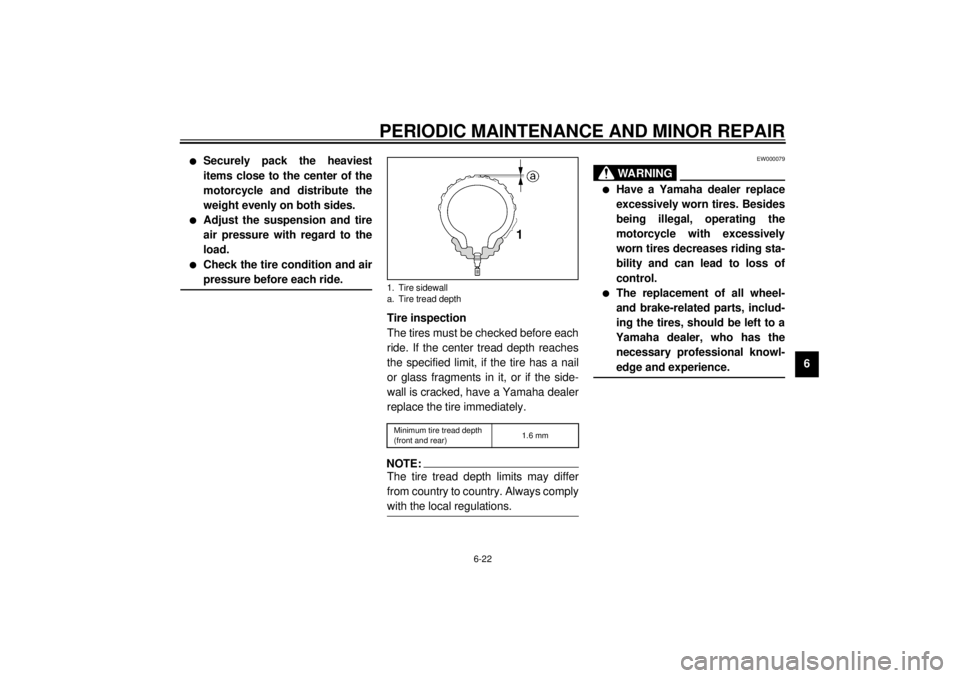
PERIODIC MAINTENANCE AND MINOR REPAIR
6-22
6
l
Securely pack the heaviest
items close to the center of the
motorcycle and distribute the
weight evenly on both sides.
l
Adjust the suspension and tire
air pressure with regard to the
load.
l
Check the tire condition and air
pressure before each ride.
_
Tire inspection
The tires must be checked before each
ride. If the center tread depth reaches
the specified limit, if the tire has a nail
or glass fragments in it, or if the side-
wall is cracked, have a Yamaha dealer
replace the tire immediately.CE-08ENOTE:_ The tire tread depth limits may differ
from country to country. Always comply
with the local regulations. _
EW000079
WARNING
_ l
Have a Yamaha dealer replace
excessively worn tires. Besides
being illegal, operating the
motorcycle with excessively
worn tires decreases riding sta-
bility and can lead to loss of
control.
l
The replacement of all wheel-
and brake-related parts, includ-
ing the tires, should be left to a
Yamaha dealer, who has the
necessary professional knowl-
edge and experience.
_
1. Tire sidewall
a. Tire tread depthMinimum tire tread depth
(front and rear)1.6 mm
E_4tv.book Page 22 Wednesday, October 4, 2000 2:15 PM
Page 72 of 114
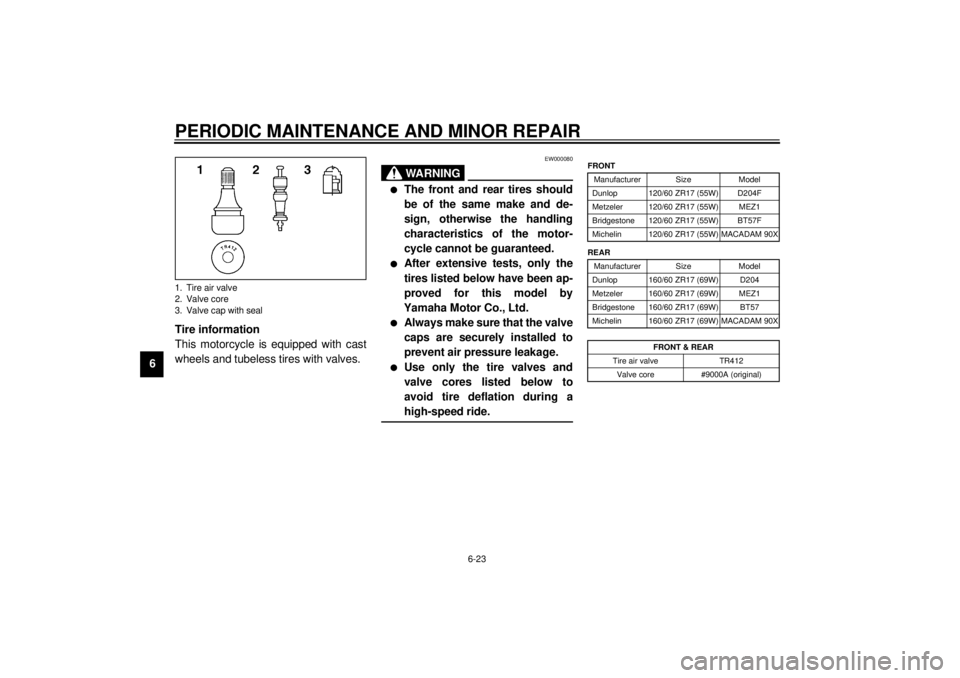
PERIODIC MAINTENANCE AND MINOR REPAIR
6-23
6Tire information
This motorcycle is equipped with cast
wheels and tubeless tires with valves.
EW000080
WARNING
_ l
The front and rear tires should
be of the same make and de-
sign, otherwise the handling
characteristics of the motor-
cycle cannot be guaranteed.
l
After extensive tests, only the
tires listed below have been ap-
proved for this model by
Yamaha Motor Co., Ltd.
l
Always make sure that the valve
caps are securely installed to
prevent air pressure leakage.
l
Use only the tire valves and
valve cores listed below to
avoid tire deflation during a
high-speed ride.
_
CE-10E
CE-14E
1. Tire air valve
2. Valve core
3. Valve cap with seal
FRONT
Manufacturer Size Model
Dunlop 120/60 ZR17 (55W) D204F
Metzeler 120/60 ZR17 (55W) MEZ1
Bridgestone 120/60 ZR17 (55W) BT57F
Michelin 120/60 ZR17 (55W) MACADAM 90X
REAR
Manufacturer Size Model
Dunlop 160/60 ZR17 (69W) D204
Metzeler 160/60 ZR17 (69W) MEZ1
Bridgestone 160/60 ZR17 (69W) BT57
Michelin 160/60 ZR17 (69W) MACADAM 90X
FRONT & REAR
Tire air valve TR412
Valve core #9000A (original)
E_4tv.book Page 23 Wednesday, October 4, 2000 2:15 PM
Page 73 of 114
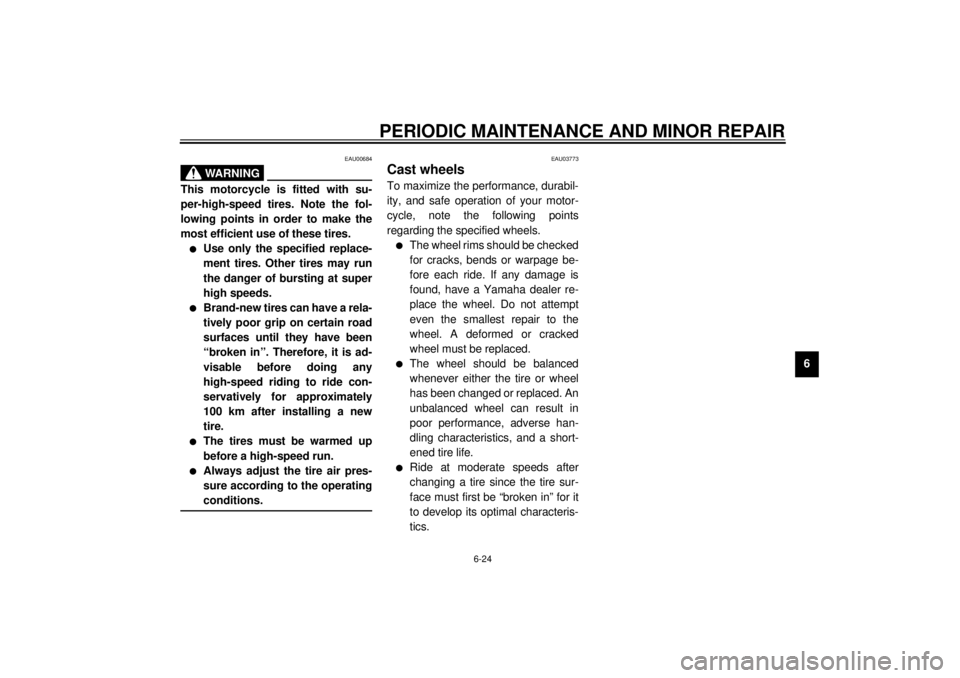
PERIODIC MAINTENANCE AND MINOR REPAIR
6-24
6
EAU00684
WARNING
_ This motorcycle is fitted with su-
per-high-speed tires. Note the fol-
lowing points in order to make the
most efficient use of these tires.l
Use only the specified replace-
ment tires. Other tires may run
the danger of bursting at super
high speeds.
l
Brand-new tires can have a rela-
tively poor grip on certain road
surfaces until they have been
“broken in”. Therefore, it is ad-
visable before doing any
high-speed riding to ride con-
servatively for approximately
100 km after installing a new
tire.
l
The tires must be warmed up
before a high-speed run.
l
Always adjust the tire air pres-
sure according to the operating
conditions.
_
EAU03773
Cast wheels To maximize the performance, durabil-
ity, and safe operation of your motor-
cycle, note the following points
regarding the specified wheels.l
The wheel rims should be checked
for cracks, bends or warpage be-
fore each ride. If any damage is
found, have a Yamaha dealer re-
place the wheel. Do not attempt
even the smallest repair to the
wheel. A deformed or cracked
wheel must be replaced.
l
The wheel should be balanced
whenever either the tire or wheel
has been changed or replaced. An
unbalanced wheel can result in
poor performance, adverse han-
dling characteristics, and a short-
ened tire life.
l
Ride at moderate speeds after
changing a tire since the tire sur-
face must first be “broken in” for it
to develop its optimal characteris-
tics.
E_4tv.book Page 24 Wednesday, October 4, 2000 2:15 PM
Page 74 of 114
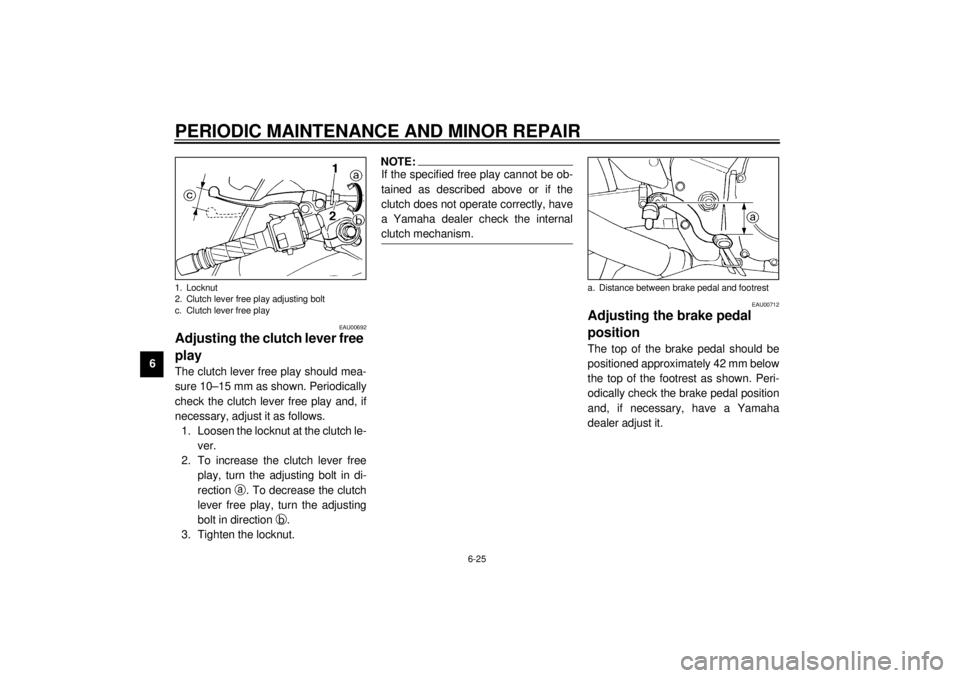
PERIODIC MAINTENANCE AND MINOR REPAIR
6-25
6
EAU00692
Adjusting the clutch lever free
play The clutch lever free play should mea-
sure 10–15 mm as shown. Periodically
check the clutch lever free play and, if
necessary, adjust it as follows.
1. Loosen the locknut at the clutch le-
ver.
2. To increase the clutch lever free
play, turn the adjusting bolt in di-
rection
a. To decrease the clutch
lever free play, turn the adjusting
bolt in direction
b.
3. Tighten the locknut.
NOTE:_ If the specified free play cannot be ob-
tained as described above or if the
clutch does not operate correctly, have
a Yamaha dealer check the internal
clutch mechanism. _
EAU00712
Adjusting the brake pedal
position The top of the brake pedal should be
positioned approximately 42 mm below
the top of the footrest as shown. Peri-
odically check the brake pedal position
and, if necessary, have a Yamaha
dealer adjust it.
1. Locknut
2. Clutch lever free play adjusting bolt
c. Clutch lever free play
a. Distance between brake pedal and footrest
E_4tv.book Page 25 Wednesday, October 4, 2000 2:15 PM
Page 75 of 114

PERIODIC MAINTENANCE AND MINOR REPAIR
6-26
6
EW000109
WARNING
_ A soft or spongy feeling in the brake
pedal can indicate the presence of
air in the hydraulic system. If there
is air in the hydraulic system, have a
Yamaha dealer bleed the system be-
fore operating the motorcycle. Air in
the hydraulic system will diminish
the braking performance, which
may result in loss of control and an
accident. _
EAU00713
Adjusting the rear brake light
switch The rear brake light switch, which is ac-
tivated by the brake pedal, is properly
adjusted when the brake light comes
on just before braking takes effect. If
necessary, adjust the brake light switch
as follows.
Turn the adjusting nut while holding the
rear brake light switch in place. To
make the brake light come on earlier,
turn the adjusting nut in direction
a. To
make the brake light come on later,
turn the adjusting nut in direction
b. 1. Rear brake light switch
2. Rear brake light switch adjusting nut
E_4tv.book Page 26 Wednesday, October 4, 2000 2:15 PM
Page 76 of 114
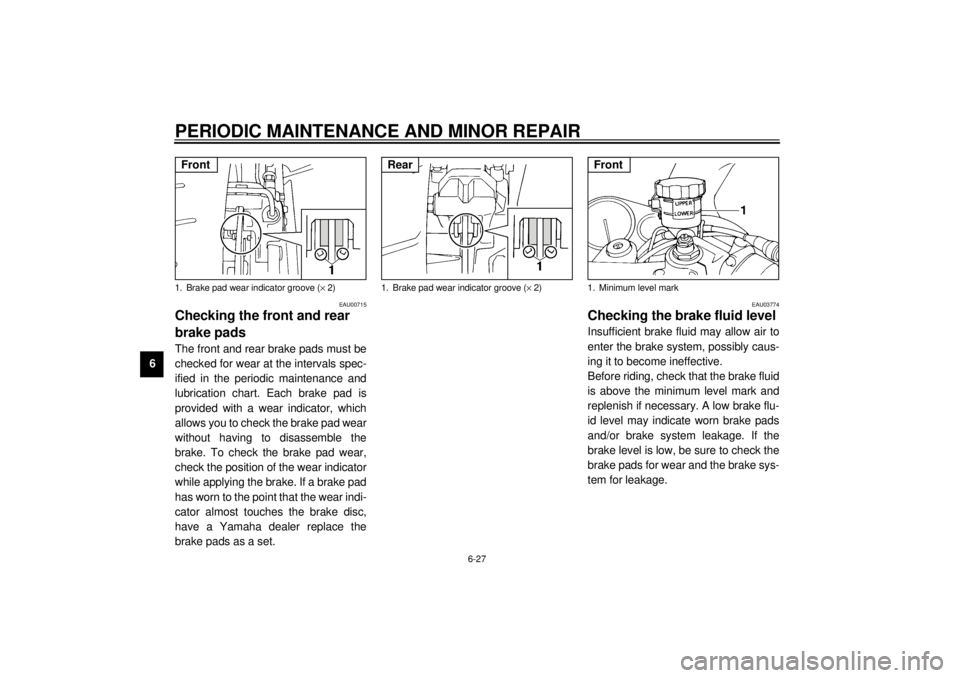
PERIODIC MAINTENANCE AND MINOR REPAIR
6-27
6
EAU00715
Checking the front and rear
brake pads The front and rear brake pads must be
checked for wear at the intervals spec-
ified in the periodic maintenance and
lubrication chart. Each brake pad is
provided with a wear indicator, which
allows you to check the brake pad wear
without having to disassemble the
brake. To check the brake pad wear,
check the position of the wear indicator
while applying the brake. If a brake pad
has worn to the point that the wear indi-
cator almost touches the brake disc,
have a Yamaha dealer replace the
brake pads as a set.
EAU03774
Checking the brake fluid level Insufficient brake fluid may allow air to
enter the brake system, possibly caus-
ing it to become ineffective.
Before riding, check that the brake fluid
is above the minimum level mark and
replenish if necessary. A low brake flu-
id level may indicate worn brake pads
and/or brake system leakage. If the
brake level is low, be sure to check the
brake pads for wear and the brake sys-
tem for leakage.
1. Brake pad wear indicator groove (´ 2)Front
1. Brake pad wear indicator groove (´ 2)Rear
1. Minimum level markFront
E_4tv.book Page 27 Wednesday, October 4, 2000 2:15 PM
Page 77 of 114
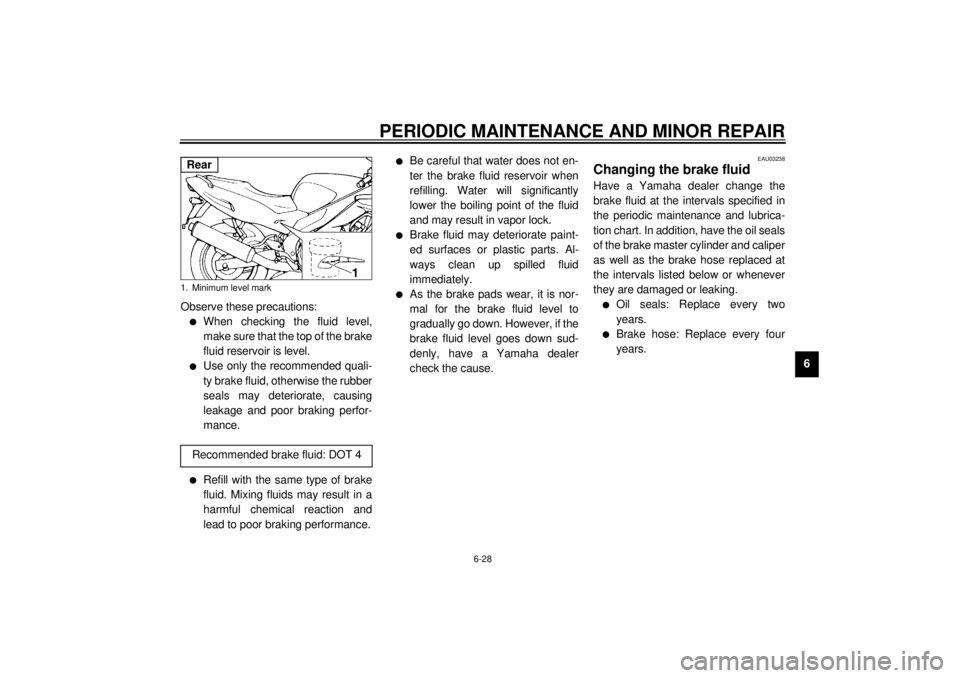
PERIODIC MAINTENANCE AND MINOR REPAIR
6-28
6 Observe these precautions:
l
When checking the fluid level,
make sure that the top of the brake
fluid reservoir is level.
l
Use only the recommended quali-
ty brake fluid, otherwise the rubber
seals may deteriorate, causing
leakage and poor braking perfor-
mance.
l
Refill with the same type of brake
fluid. Mixing fluids may result in a
harmful chemical reaction and
lead to poor braking performance.
l
Be careful that water does not en-
ter the brake fluid reservoir when
refilling. Water will significantly
lower the boiling point of the fluid
and may result in vapor lock.
l
Brake fluid may deteriorate paint-
ed surfaces or plastic parts. Al-
ways clean up spilled fluid
immediately.
l
As the brake pads wear, it is nor-
mal for the brake fluid level to
gradually go down. However, if the
brake fluid level goes down sud-
denly, have a Yamaha dealer
check the cause.
EAU03238
Changing the brake fluid Have a Yamaha dealer change the
brake fluid at the intervals specified in
the periodic maintenance and lubrica-
tion chart. In addition, have the oil seals
of the brake master cylinder and caliper
as well as the brake hose replaced at
the intervals listed below or whenever
they are damaged or leaking.l
Oil seals: Replace every two
years.
l
Brake hose: Replace every four
years.
1. Minimum level mark
Recommended brake fluid: DOT 4Rear
E_4tv.book Page 28 Wednesday, October 4, 2000 2:15 PM
Page 78 of 114
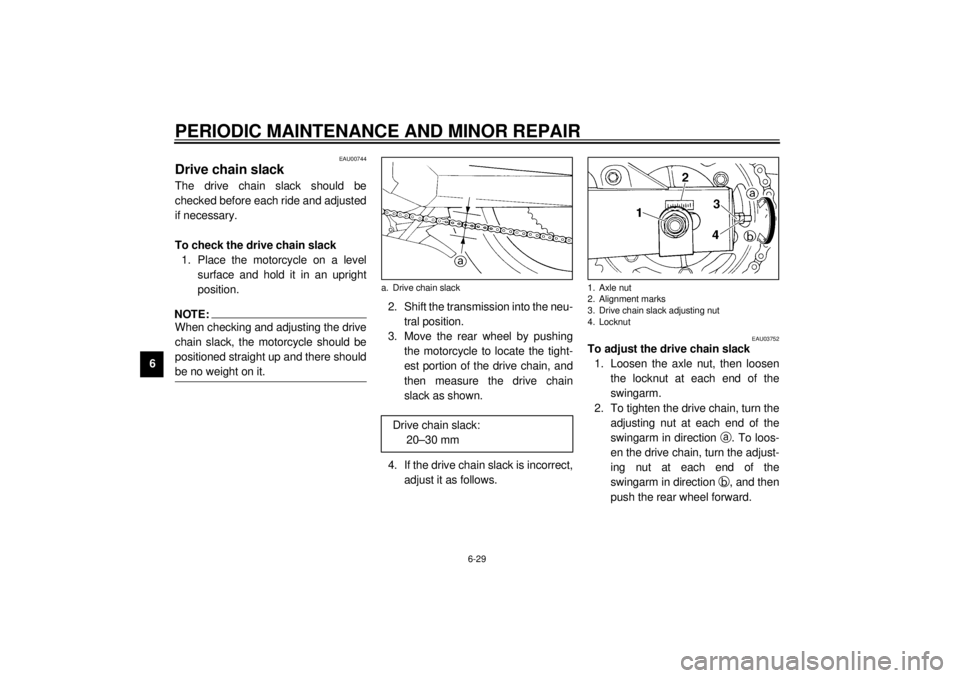
PERIODIC MAINTENANCE AND MINOR REPAIR
6-29
6
EAU00744
Drive chain slack The drive chain slack should be
checked before each ride and adjusted
if necessary.
To check the drive chain slack
1. Place the motorcycle on a level
surface and hold it in an upright
position.NOTE:_ When checking and adjusting the drive
chain slack, the motorcycle should be
positioned straight up and there should
be no weight on it. _
2. Shift the transmission into the neu-
tral position.
3. Move the rear wheel by pushing
the motorcycle to locate the tight-
est portion of the drive chain, and
then measure the drive chain
slack as shown.
4. If the drive chain slack is incorrect,
adjust it as follows.
EAU03752
To adjust the drive chain slack
1. Loosen the axle nut, then loosen
the locknut at each end of the
swingarm.
2. To tighten the drive chain, turn the
adjusting nut at each end of the
swingarm in direction
a. To loos-
en the drive chain, turn the adjust-
ing nut at each end of the
swingarm in direction
b, and then
push the rear wheel forward.
a. Drive chain slack
Drive chain slack:
20–30 mm
1. Axle nut
2. Alignment marks
3. Drive chain slack adjusting nut
4. Locknut
E_4tv.book Page 29 Wednesday, October 4, 2000 2:15 PM
Page 79 of 114
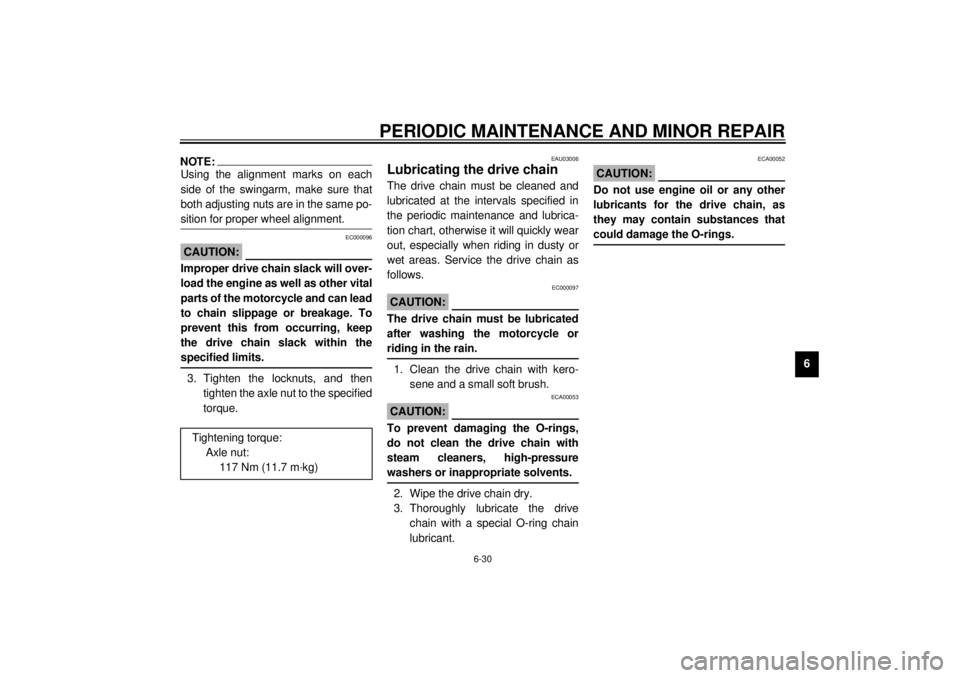
PERIODIC MAINTENANCE AND MINOR REPAIR
6-30
6
NOTE:_ Using the alignment marks on each
side of the swingarm, make sure that
both adjusting nuts are in the same po-
sition for proper wheel alignment. _
EC000096
CAUTION:_ Improper drive chain slack will over-
load the engine as well as other vital
parts of the motorcycle and can lead
to chain slippage or breakage. To
prevent this from occurring, keep
the drive chain slack within the
specified limits. _3. Tighten the locknuts, and then
tighten the axle nut to the specified
torque.
EAU03006
Lubricating the drive chain The drive chain must be cleaned and
lubricated at the intervals specified in
the periodic maintenance and lubrica-
tion chart, otherwise it will quickly wear
out, especially when riding in dusty or
wet areas. Service the drive chain as
follows.
EC000097
CAUTION:_ The drive chain must be lubricated
after washing the motorcycle or
riding in the rain. _1. Clean the drive chain with kero-
sene and a small soft brush.
ECA00053
CAUTION:_ To prevent damaging the O-rings,
do not clean the drive chain with
steam cleaners, high-pressure
washers or inappropriate solvents. _2. Wipe the drive chain dry.
3. Thoroughly lubricate the drive
chain with a special O-ring chain
lubricant.
ECA00052
CAUTION:_ Do not use engine oil or any other
lubricants for the drive chain, as
they may contain substances that
could damage the O-rings. _
Tightening torque:
Axle nut:
117 Nm (11.7 m·kg)
E_4tv.book Page 30 Wednesday, October 4, 2000 2:15 PM
Page 80 of 114
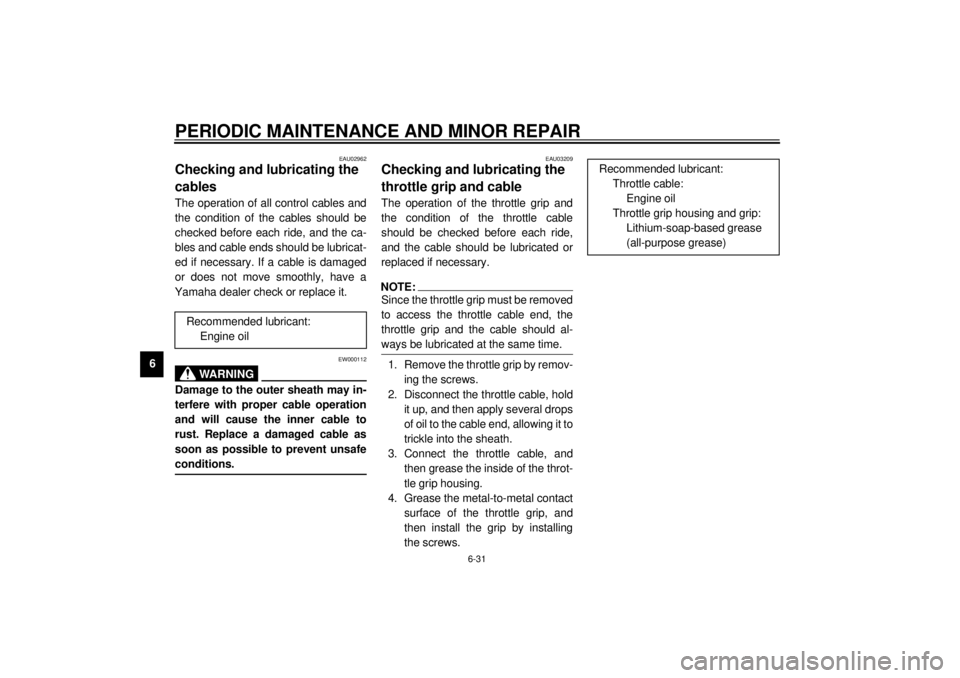
PERIODIC MAINTENANCE AND MINOR REPAIR
6-31
6
EAU02962
Checking and lubricating the
cables The operation of all control cables and
the condition of the cables should be
checked before each ride, and the ca-
bles and cable ends should be lubricat-
ed if necessary. If a cable is damaged
or does not move smoothly, have a
Yamaha dealer check or replace it.
EW000112
WARNING
_ Damage to the outer sheath may in-
terfere with proper cable operation
and will cause the inner cable to
rust. Replace a damaged cable as
soon as possible to prevent unsafe
conditions. _
EAU03209
Checking and lubricating the
throttle grip and cable The operation of the throttle grip and
the condition of the throttle cable
should be checked before each ride,
and the cable should be lubricated or
replaced if necessary.NOTE:_ Since the throttle grip must be removed
to access the throttle cable end, the
throttle grip and the cable should al-
ways be lubricated at the same time. _1. Remove the throttle grip by remov-
ing the screws.
2. Disconnect the throttle cable, hold
it up, and then apply several drops
of oil to the cable end, allowing it to
trickle into the sheath.
3. Connect the throttle cable, and
then grease the inside of the throt-
tle grip housing.
4. Grease the metal-to-metal contact
surface of the throttle grip, and
then install the grip by installing
the screws. Recommended lubricant:
Engine oil
Recommended lubricant:
Throttle cable:
Engine oil
Throttle grip housing and grip:
Lithium-soap-based grease
(all-purpose grease)
E_4tv.book Page 31 Wednesday, October 4, 2000 2:15 PM